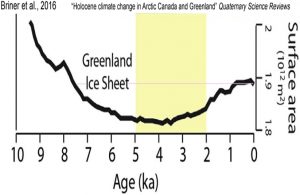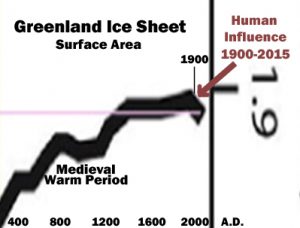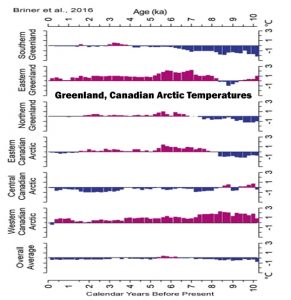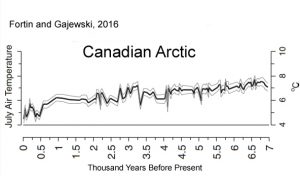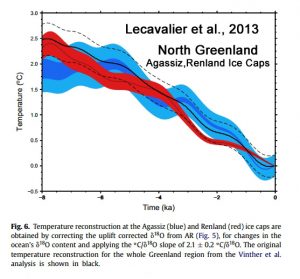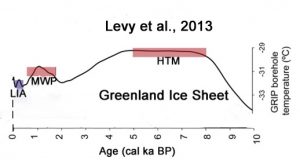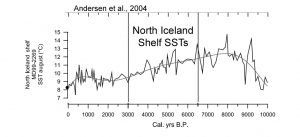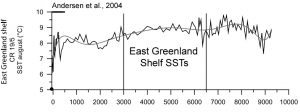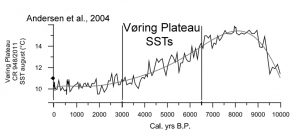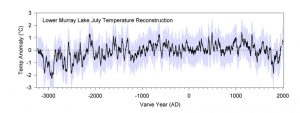By Kenneth Richard on 15. December 2016
Fifteen international scientists recently collaborated to assemble one of the most comprehensive analyses of temperature and ice sheet changes for Greenland and the Canadian Arctic ever produced. Briner et al., (2016) synthesized over 100 records from a large and accumulating database to publish “Holocene climate change in Arctic Canada and Greenland” in the journal Quaternary Science Reviews.
The results are not good news for those who wish to maintain that today’s Greenland Ice Sheet is losing ice area at an unprecedentedly accelerated rate, or that modern temperature values for the Arctic region are dangerously high. Greenland’s Ice Sheet has a larger ice extent now than it has had for most of the last 7,500 years; only the Little Ice Age period (~1300-1900 A.D.) had more ice mass. And both regions (Canadian Arctic and Greenland) are still 1 to 2°C colder now than they were just a few thousand years ago.
The Greenland Ice Sheet Is Now At Nearly Its Highest Extent In The Last 7,500 Years
In the climate alarmism world, the Greenland Ice Sheet has been cooperating with the ice-is-melting-faster-than-ever paradigm for decades. For headline-creators who warn of “ominous” and “catastrophic” rates of change — and how humans are to blame for most of it — the Greenland Ice Sheet has been losing mass at “unprecedented” rates since the 1990s. For example: The Greenland Ice Sheet is losing 110 million Olympic size swimming pools worth of water each year. … ‘The Arctic Is Unraveling,’ Scientists Conclude After Latest Sobering Climate Report – Unprecedented warming has sent the Arctic into uncharted territory, says latest NOAA report … Alert! Greenland’s Ice Now Melting At Catastrophic Speed
But what does “unprecedented” actually mean with regard to ice loss or temperature change in the Arctic? Effectively, precedence only extends back to the beginning of the 20th Century in most cases. Some may only extend precedence back to the 1961-1990 period, which is the baseline for nearly all surface mass balance estimates. So ice is said to be melting faster than any time since 1900, or since 1961-1990. But consider that in 1900, with centuries of solar minima and large-scale volcanic eruptions leading to plummeting Little Ice Age temperatures, the Greenland Ice Sheet had accumulated more ice and expanded its margins more than at any time in the last 7,500 years. And as the 15 scientists contributing to Briner et al. (2016) reveal in this encapsulating graph from the paper, the Greenland Ice Sheet’s surface area has only negligibly retreated from that high point (~1900). Today’s ice sheet extent is still among the highest of the Holocene.
Briner et al., 2016 “The Greenland Ice Sheet retracted to its minimum extent between 5 and 3 ka [5,000 and 3,000 years ago], consistent with many sites from around Greenland depicting a switch from warm to cool conditions around that time.”
Taking a closer look at what this graph depicts, we first of all can clearly see that Greenland’s ice sheet reached its much-lower-than-now minimum extent between 6,000 and 2,000 years ago, with the absolute lowest levels between 5,000 and 3,000 years ago. This millennial-scale ice sheet recession took place at a time when an anthropogenic influence was non-existent, and when CO2 levels were safely in the range of 260 ppm – about 140 ppm lower than today’s levels (400 ppm).
And as mentioned above, it is also clearly discernible that the modern Greenland Ice Sheet extent has not only not fallen outside the range of natural variability, it barely even falls below the coldest centennial-scale periods of the last 10,000 years (the Little Ice Age). Here is a much closer look (with annotations) at the last ~1,500 years of Greenland Ice Sheet area changes as shown in Briner et al. (2016):
Greenland and Canadian Arctic Temperatures Were 2°C Warmer Than Now For Most Of The Last 10,000 Years
Not only did Greenland’s ice sheet margins experience far greater retreat and higher melt rates during most of the last 7,500 years, but Greenland’s (and the Canadian Arctic’s) temperatures were also much warmer than today’s during the Holocene too. Below are some of the summarizing comments from Briner et al. (2016) describing the temperature changes for this region. Again, these much warmer temperatures occurred while CO2 levels were in the 260 ppm range.
“The temperature decrease from the warmest to the coolest portions of the Holocene is 3.0 ± 1.0 °C on average (n = 11 sites). … The temperature record, which integrates all seasons, shows rapid warming from the onset of the Holocene until ~9.5 ka [9,500 years ago], relatively uniform temperature at the millennial scale until ~7 ka [7,000 years ago], followed by ~3.5 °C temperature decline to the Little Ice Age [1300-1900 C.E.], followed by ~1.5 °C warming to today. [Today’s Greenland Ice Sheet temperatures are 2.0 °C colder than the Early and Middle Holocene] . The record also shows centennial-scale variability on the order of 1-2 °C, and a ~3 °C temperature oscillation during the 8.2 ka event.”
“Reconstruction results [Canadian Arctic] showed that summers warmer than today (~1 to 2 °C) prevailed prior to 4-3 ka [4,000 to 3,000 years ago]. … At Qipisarqo Lake [Greenland], pollen data indicate a sharp increase in July air temperature of 3-4 °C at 7.5-7.0 ka [7,500 to 7,000 years ago] and higher temperatures until 5.5-5.0 ka [5,500 to 5,000 years ago]. After 5 ka [5,000 years ago], a progressive cooling of 1-2 °C is inferred.”
Another synopsized graph from the paper depicting the temperature changes for each region of Greenland and the Canadian Arctic yields a clear and decisive verdict: modern Arctic-region temperature changes are not unusual or unprecedented.
Other New Papers Confirm That Modern Temperatures, Ice Loss Not At All Unusual For the Arctic Region
In the last few decades, the interior of the Greenland Ice Sheet has been melting at a slower rate than it did for 95% of the last 9,000 years according to scientists publishing in the journal Science. This finding is similar to the aforementioned conclusion that the ice extent for the Greenland Ice Sheet is now higher than it was for more than 90% of the last 7,500 years, rendering recent “losses” relatively insignificant and well within the range of natural variability.
MacGregor et al., 2016 [press release] (Greenland Ice Sheet)
“[I]ce flow in its [the Greenland Ice Sheet’s] interior is slower now than the average speed over the past nine millennia.”
“[T]he interior of the GrIS [Greenland Ice Sheet] is flowing 95% slower now than it was on average during the Holocene [the last 9,000 years].”
—
Fortin and Gajewski (2016) find that the central Canadian Arctic has not warmed in the last 150 years, and that the region was 3°C warmer than now just a few thousand years ago.
Fortin and Gajewski, 2016 (Canadian Arctic)
“A study of chironomid remains in the sediments of Lake JR01 on the “Boothia Peninsula in the central Canadian Arctic provides a high-resolution record of mean July air temperatures for the last 6.9 ka …. Biological production decreased again at ~ 2 ka and the rate of cooling increased in the past 2 ka, with coolest temperatures occurring between 0.46 and 0.36 ka [460 and 360 years ago], coinciding with the Little Ice Age. Although biological production increased in the last 150 yr, the reconstructed temperatures do not indicate a warming during this time. … Modern inferred temperatures based on both pollen and chironomids are up to 3°C cooler than those inferred for the mid-Holocene.”
—
Spolaor et al., 2016 [press release] (Arctic Ocean, Region)
“Researchers have found that 8000 years ago the Arctic climate was 2 to 3 degrees warmer than now, and that there was also less summertime Arctic sea ice than today.”
Other Recent Reconstructions Of Greenland, Canadian Arctic Climate Also Do Not Indicate ‘Unprecedented’ Modern Changes
Lecavalier et al., 2013 (North Greenland)
Levy et al., 2013 (Greenland Ice Sheet)
Andersen et al., 2004 (North Iceland Shelf, East Greenland, Vøring Plateau SSTs)
“Our results show that the Nordic Seas circulation system is highly sensitive to the large-scale insolation [surface solar radiation] changes as the general Holocene climate development follows closely the Northern Hemisphere insolation. … Century-scale surface current variability for the Holocene is shown to be 1 – 1.5°C for the Vøring Plateau and East Greenland shelf, and 2.5– 3°C on the North Ice-land shelf. … The first cooling [East Greenland Shelf SSTs] from 2400 to 2000 cal years BP was introduced by a 1.5°C temperature drop starting at 3000 cal years BP which culminated in an SST low around 2100 cal years BP. The second cooling occurred around 300 cal years BP and preceded a rapid warming [during the 1700s A.D.] , where SSTs rose with more than 1.5°C within 70 years. The third cooling took place in the second half of the last century. Until the last three centuries, SST variability atthis site has been 1°C, while SSTs varied with amplitudes of 1.5– 2°C during the last 300 years.”
Cook et al., 2009 (Canadian Arctic)
Remember The Larger Context For Claims Of ‘Unprecedented’ Arctic Change
Geologist Dr. Don Easterbrook offers a cogent summarizing perspective on the modern levels of relative Arctic quiescence.
“In the past 500 years, Greenland temperatures have fluctuated back and forth between warming and cooling about 40 times, with changes every 25–30 years. … Comparisons of the intensity and magnitude of past warming and cooling climate changes show that the global warming experienced during the past century pales into insignificance when compared to the magnitude of profound climate reversals over the past 25,000 years. At least three warming events were 20–24 times the magnitude of warming over the past century, and four were 6–9 times the magnitude of warming over the past century.”
So the next time we read a headline that uses words like dangerous and catastrophic and unprecedented to refer to Arctic temperatures or ice mass losses, let’s remember that the far larger context strongly suggests that modern changes in the Arctic are comparatively minor, even negligible.
– See more at: http://notrickszone.com/2016/12/15/scientists-greenland-is-now-much-colder-with-more-advanced-ice-sheet-margins-than-90-of-the-last-7500-years/#sthash.YmPuMj2W.iSQSnlgQ.dpuf

